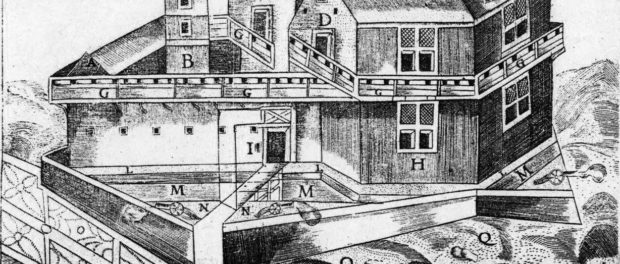1620s and 1630s: Early Quebec & Other Quebec Curios
Je me souviens: New France, 1534–1763
While Trois-Rivières, the second permanent city founded in New France, was just being created in 1634, the city of Quebec had been growing slowly since 1608. Not just a trading post, Quebec was the first settlement intended for a permanent population. From the time Champlain founded Quebec, it seemed that the colony was in peril, and not only because of the harsh climate. The colony, placed in a favourable place for trading, was also in the sights of the English: despite quite a few attempted invasions, after the English were forced to give back the colony in the 1620s, the English were successful only once at taking over the colony, in the 1760s. But between the 1620s and the 1760s, how did Quebec end up growing? What did an early Quebec look like?
In order to grow a colony, Quebec needed to be protected, and more importantly, have its population grow. Surprisingly, early Quebec was barely protected and fortifications were little to non-existent, which made it prone to attacks and sieges. Quebec’s de facto chief, of course, was none other than Samuel de Champlain. Officially called the Lieutenant Governor of New France, the population nonetheless named Champlain their very own governor. Since Champlain’s reinstatement as governor, he took back the powers that he had prior to Quebec’s short-lived conquest by the English in the 1620s: apart from economic and financial powers, which he did not have, Champlain would have been able to make military decisions as well as preside over civil matters. Due to his powers, as well as his association to Cardinal Richelieu, he was governor in all but name. However, in order to exercise his powers and to see over civil matters, the colony needed people.
The people part of Quebec came gradually. People already settled in Quebec included artisans and farmers, but mostly people in commerce. In order to grow this population, starting in the 1620s, Cardinal Richelieu gave the Company of One Hundred Associates, of which he was a major stakeholder, a monopoly in New France. This monopoly meant wonders for the business of this company: not only the vast majority of the discovered territory of New France, including the shores of Quebec City and Montreal Island, it would also include, most importantly, a monopoly on the fur trade. In exchange for this monopoly of territory and commerce, Richelieu (and King Louis XIII, no doubt) expected the Company to supply two hundred colonists in order to build up the territory by 1628, and thousands more following the next few years.
By 1633, the Company hadn’t lived up to its promises, delivering only two hundred people. To counteract this, the Company had an ingenious idea: the seigneurial system. By distributing lands to whoever would take them and hiring indentured people for thirty years to tend to the land, the early colony enjoyed a small growth in population. With New France at odds with the Iroquois, whose territory they had taken as their own, Quebec’s early days were slow going. Advertisement campaigns can only go so far. In order to grow further, Quebec would need more than workers: it would need teachers and it would need children.






